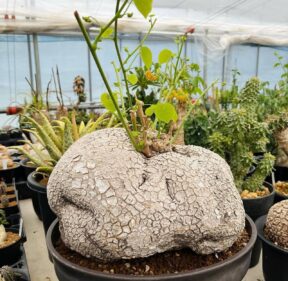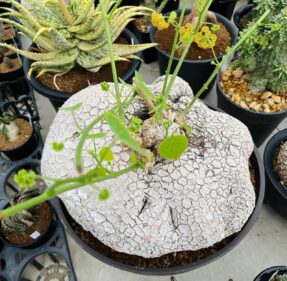- Your cart is empty
- Continue shopping
Explore the unique beauty and medicinal benefits of Stephania suberosa, a caudex plant prized for its heart-shaped leaves and therapeutic properties.
Stephania suberosa, commonly known as the “Snake Vine” or “Caudex Plant,” is a unique and captivating species native to Southeast Asia, particularly Thailand and Cambodia. Renowned for its distinctive bulbous base and heart-shaped leaves, this plant has garnered attention among succulent enthusiasts and herbalists alike.Facebook Belonging to the Menispermaceae family, S. suberosa exhibits remarkable adaptability and resilience, thriving in various environmental conditions.caudexplants.com

Stephania suberosa is characterized by its large, round tuber or caudex, which serves as a storage organ during periods of dormancy. From this tuber, slender vines emerge, bearing broad, green leaves that are heart-shaped with prominent veins. The plant’s growth cycle is marked by a distinct dormancy phase during the winter months, during which it sheds its leaves and retreats into its tuber, conserving energy and moisture. This adaptation enables S. suberosa to endure adverse conditions and periods of drought.caudexplants.com
Cultivating Stephania suberosa requires attention to its specific environmental needs:
Light: Place the plant in a bright location with indirect sunlight. Direct exposure to harsh sunlight can scorch its leaves.caudexplants.com
Watering: During the growing season (spring and summer), water the plant moderately, allowing the soil to dry out between waterings. In the dormant phase (fall and winter), reduce watering significantly to prevent root rot.
Soil: Utilize well-draining soil, such as cactus or succulent mix, to ensure proper root aeration and prevent water accumulation.
Temperature: Maintain temperatures between 23°C and 28°C (73°F to 82°F) during the growing season. Avoid exposure to temperatures below 15°C (59°F) to prevent cold damage.
Humidity: S. suberosa prefers moderately high humidity levels. Regular misting can help maintain adequate moisture in the air, especially in dry indoor environments.
Fertilization: During the active growing phase, apply a diluted, balanced fertilizer every 4–6 weeks to support healthy growth..caudexplants.com
Stephania suberosa has been utilized in traditional medicine for its various therapeutic properties:
Antihypertensive: The plant has been employed to manage high blood pressure, contributing to cardiovascular health.
Anti-inflammatory: Its compounds possess anti-inflammatory effects, aiding in the reduction of inflammation-related conditions.
Analgesic: S. suberosa is used to alleviate pain, providing relief from various discomforts.
Antioxidant: The plant’s antioxidant properties help combat oxidative stress, supporting overall health.
Antimicrobial: Studies have indicated that extracts from S. suberosa exhibit activity against certain bacterial strains, including ampicillin-resistant Staphylococcus aureus. .caudexplants.com
These medicinal applications highlight the potential of Stephania suberosa as a valuable resource in herbal medicine..caudexplants.com

In its native habitats, Stephania suberosa plays a role in the local ecosystem by:
Soil Stabilization: Its root system helps in preventing soil erosion, maintaining soil integrity.
Biodiversity Support: The plant provides habitat and sustenance for various local fauna, contributing to the biodiversity of its environment.
Water Conservation: Through its drought-resistant adaptations, S. suberosa conserves water resources, which is crucial in arid regions..caudexplants.com
Stephania suberosa is a remarkable plant that combines aesthetic appeal with practical benefits. Its unique growth habits, medicinal properties, and ecological contributions make it a valuable addition to both ornamental gardens and herbal medicine practices. With proper care and attention, cultivating S. suberosa can be a rewarding endeavor for plant enthusiasts and health practitioners alike.
